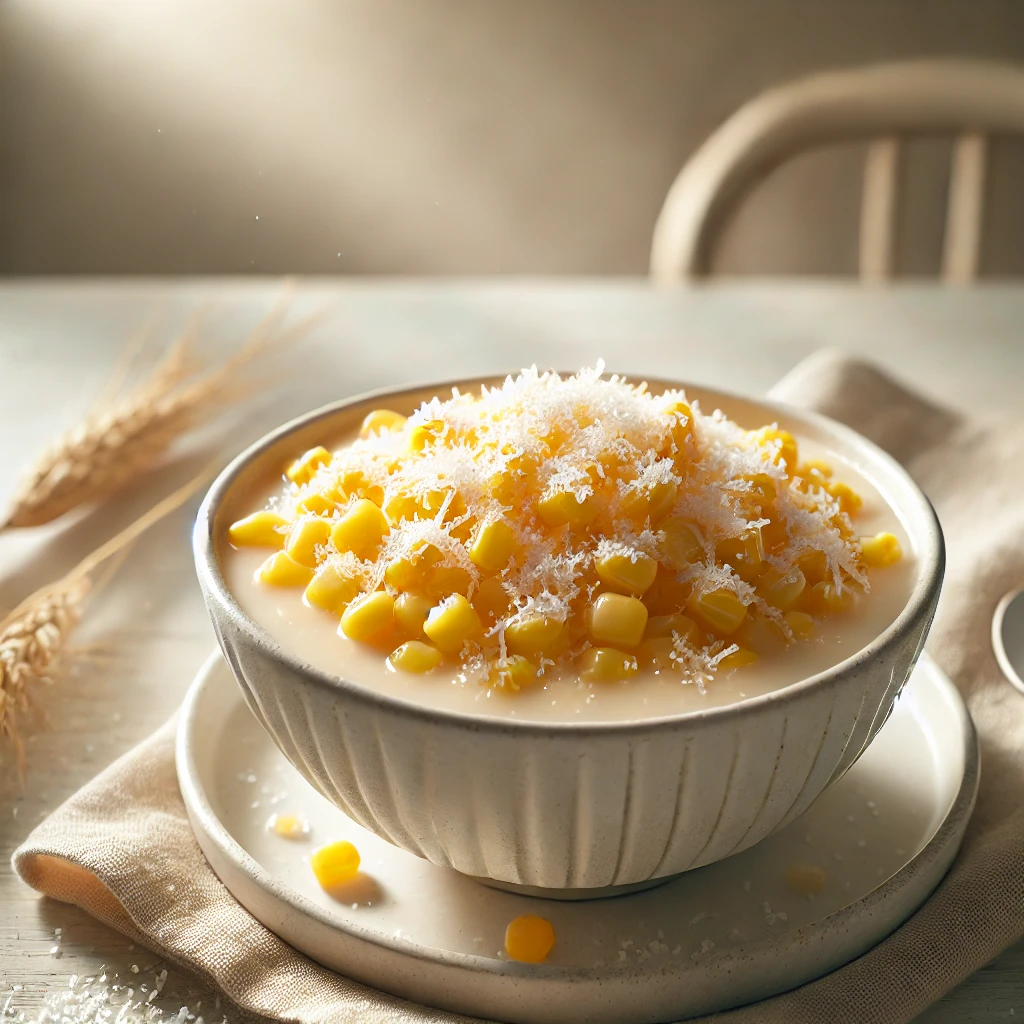Picture this: You’re strolling through a bustling Filipino street market, the air filled with a symphony of enticing aromas. Suddenly, a vendor’s cheerful call catches your attention: “Binatog! Mainit na binatog!” (Hot boiled corn kernels!). Your curiosity piqued, you approach the cart to discover a simple yet irresistible treat that has been delighting Filipinos for generations.
Binatog, a beloved Filipino street food, is a humble yet satisfying snack that combines the wholesome goodness of boiled white corn kernels with the tropical sweetness of freshly grated coconut and a sprinkle of sugar. This unpretentious dish perfectly embodies the Filipino culinary philosophy of creating something extraordinary from simple, readily available ingredients.
What sets binatog apart is its unique texture and flavor profile. The corn kernels, slightly chewy and bursting with natural sweetness, provide a satisfying base. The grated coconut adds a creamy, tropical dimension, while the sugar elevates the sweetness to create a harmonious blend of flavors and textures that dance on your palate.
For those with dietary restrictions, binatog is a natural choice. It’s inherently gluten-free, making it suitable for those with celiac disease or gluten sensitivities. The recipe can also be easily adapted for vegan diets by omitting the optional butter. With its wholesome ingredients and simple preparation, binatog is a guilt-free indulgence that satisfies cravings while providing a good dose of fiber and essential nutrients.
Recipe Ingredients
To bring the taste of Filipino street food to your home, gather these simple ingredients:
| Ingredient | Quantity | Notes |
|---|---|---|
| White corn kernels (mature) | 2 cups | Dried or fresh |
| Freshly grated coconut | 1 cup | Unsweetened |
| White sugar | 1/4 cup | Adjust to taste |
| Salt | 1/4 teaspoon | For boiling corn |
| Water | As needed | For boiling corn |
| Butter (optional) | 1 tablespoon | For added richness |
Substitution suggestions:
- If fresh white corn is unavailable, use dried white hominy corn (found in many grocery stores’ international sections).
- Frozen grated coconut can be used if fresh is not available.
- For a healthier twist, substitute white sugar with coconut sugar or stevia.
Recipe Instructions
Follow these steps to create your own delicious batch of binatog:
- Prepare the corn:
If using dried corn kernels, soak them overnight in water. For fresh corn, remove the kernels from the cob. - Cook the corn:
Place the corn kernels in a large pot and cover with water. Add the salt and bring to a boil over high heat. Reduce the heat to medium-low and simmer for about 1 hour or until the kernels are tender but still slightly chewy. Drain the corn and set aside. - Prepare the coconut:
If using a fresh coconut, crack it open and grate the white flesh. If using frozen grated coconut, thaw it according to package instructions. - Assemble the binatog:
In a large bowl, combine the cooked corn kernels and grated coconut. Mix gently to distribute the coconut evenly. - Add the finishing touches:
Sprinkle the sugar over the corn and coconut mixture. If using butter, add it while the corn is still warm so it melts slightly. - Serve and enjoy:
Divide the binatog into individual serving bowls or cups. Serve immediately while still warm for the best flavor and texture.
Recipe Tips & Variations
To elevate your binatog experience, consider these tips and variations:
- Texture tip: For the perfect texture, cook the corn until it’s tender but still has a slight chew. Overcooked corn can become mushy and lose its appealing bite.
- Flavor variations:
- Add a pinch of cinnamon or vanilla extract for a subtle aromatic twist.
- Drizzle with condensed milk for an extra indulgent treat.
- Sprinkle with toasted sesame seeds for a nutty crunch.
- Serving suggestions:
- Serve binatog in banana leaves or coconut shells for an authentic Filipino presentation.
- Offer additional toppings like crushed peanuts or toasted coconut flakes for added texture.
- Storage instructions:
Binatog is best enjoyed fresh, but leftovers can be stored in an airtight container in the refrigerator for up to 2 days. Reheat gently in the microwave or on the stovetop, adding a splash of water if needed to restore moisture.
Nutritional Information
While exact nutritional values may vary depending on specific ingredients and portions, here’s an approximate breakdown per serving (assuming 4 servings from this recipe):
| Nutrient | Amount per Serving |
|---|---|
| Calories | 250-300 |
| Carbohydrates | 45-50g |
| Protein | 5-7g |
| Fat | 8-10g |
| Fiber | 6-8g |
| Sugar | 15-20g |
The Cultural Significance of Binatog
Binatog holds a special place in Filipino culinary culture, embodying the ingenuity and resourcefulness of the Filipino people. This simple snack has its roots in the agricultural traditions of the Philippines, where corn has been a staple crop for centuries. The combination of corn with coconut and sugar reflects the abundance of these ingredients in the tropical archipelago.
In many Filipino communities, binatog is more than just a snack; it’s a nostalgic reminder of childhood and simpler times. The sight and smell of a binatog vendor pushing their cart through the neighborhood often evokes fond memories for many Filipinos. It’s a food that connects generations, with recipes and techniques passed down from grandparents to parents to children.
The popularity of binatog also highlights the Filipino love for street food. In a country where communal eating and sharing are deeply ingrained in the culture, street food like binatog serves as a great equalizer. Rich or poor, young or old, everyone can enjoy this humble yet satisfying treat.
The Nutritional Benefits of Binatog
While binatog is often enjoyed as a treat, it also offers several nutritional benefits:
- Fiber-rich: The corn kernels provide a good source of dietary fiber, which aids in digestion and promotes feelings of fullness.
- Energy boost: The natural sugars in the corn and added sugar offer a quick energy boost, making binatog a popular snack for students and workers.
- Essential nutrients: Corn contains various vitamins and minerals, including vitamin C, thiamin, and folate.
- Healthy fats: The coconut provides medium-chain triglycerides (MCTs), which are believed to have various health benefits.
- Gluten-free option: For those with gluten sensitivities, binatog offers a tasty, naturally gluten-free snack option.
Binatog in Modern Filipino Cuisine
While binatog remains a beloved street food, creative Filipino chefs have begun incorporating it into modern culinary creations. Here are some innovative ways binatog is being reimagined:
- Binatog ice cream: The flavors of binatog are transformed into a creamy, frozen dessert, often topped with toasted coconut flakes.
- Binatog pudding: A comforting dessert that combines the traditional ingredients of binatog in a smooth, creamy pudding form.
- Binatog-inspired cocktails: Mixologists have created cocktails that capture the essence of binatog, often using coconut rum as a base and incorporating corn and coconut elements.
- Binatog salad: A savory twist on the classic, incorporating vegetables and a tangy dressing for a refreshing side dish.
These modern interpretations showcase the versatility of binatog and its enduring appeal in Filipino cuisine.
Binatog is more than just a simple snack; it’s a taste of Filipino culture and hospitality. Its unpretentious nature belies the depth of flavor and satisfaction it provides. Whether you’re enjoying it from a street vendor in Manila or making it in your own kitchen halfway across the world, binatog offers a moment of pure culinary joy.
I invite you to try this recipe and experience the magic of binatog for yourself. As you savor each spoonful, imagine the bustling streets of the Philippines and the generations of people who have found comfort in this humble treat. Don’t be surprised if you find yourself craving it regularly – many have fallen under the spell of this unassuming yet irresistible snack!
If you enjoyed this recipe, I encourage you to explore more Filipino dishes. The cuisine of the Philippines is a treasure trove of flavors waiting to be discovered. From savory adobo to sweet halo-halo, each dish tells a story of the country’s rich cultural heritage and culinary ingenuity.
Share your binatog experience with friends and family, and don’t forget to experiment with your own variations. Who knows? You might create a new family favorite! Happy cooking, and may your kitchen be filled with the warmth and joy that binatog brings to so many.
Disclaimer: This recipe blog post contains information available up to 2019. While we strive for accuracy, culinary trends and nutritional understandings may have evolved since then. We encourage readers to consult current sources for the most up-to-date information. If you notice any inaccuracies, please report them so we can promptly make corrections.




